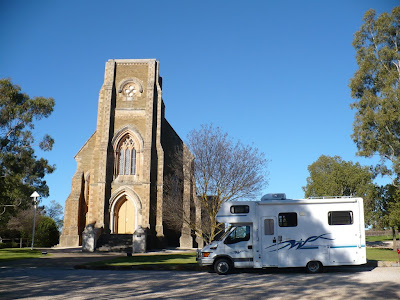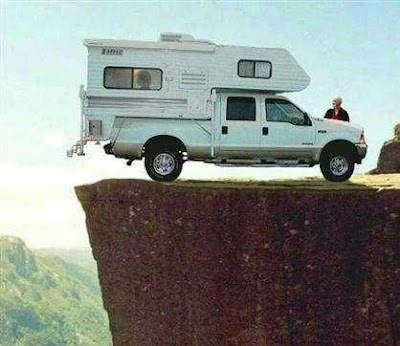We have left Adelaide and are moving north. We toyed with touring around the Yorke peninsula west of Adelaide ( to give Nancy the complex polygon she requested after pointing out that the map was becoming a little tedious) but decided to start the big push to Darwin.
We are in the Clare Valley, another wine region north of the Barossa Valley. Apparently Jamie Oliver served Clare Valley 'boutique' wines at Brad Pitt's birthday party in 2004 but who am I to name drop? It was also the first wine region in Aus to champion the screw cap over the cork.
The most unusual winery we have visited to date was Sevenhill- established by Jesuit priests in 1848 who had fled from persecution in Silesia.
Three years later they planted the Valley's first grapes and began making sacramental wine, which they still make today.The cellars are crammed with oak barrels full of the stuff . At the same time St. Aloysius church was built ( conveniently on site at the winery ).

To this day the wine makers are still Jesuit monks, and they produce sacramental wine in enormous quantities. They also produce several wines for the standard market and we tasted a couple of very clean Rieslings....I am not sure whether the description on the tasting notes of a wine ' of extreme purity' was a piss take or not.
I was interested to stop in a tiny town called Penwortham. Penwortham in Lancashire is where I went to school and my brother and his family still reside there. It was established and named by John Horrocks ( a good Lancashire name if ever I heard one ) so a bit more research was required.
John Ainsworth Horrocks, born Penwortham, Preston 1818, emigrated to Australia in 1839. He brought with him a family servant, a blacksmith, a shepherd, four merino rams, sheepdogs, tools, sufficient clothing for five years, and a church bell. He built up a flock of 9000 sheep and established one of the earliest vineyards in the Clare district ( whether he got there first or the Jesuits beat him to it remains unclear).
Bored with farming he rented out most of his properties. 'I want a more stirring life', he wrote, and proposed an expedition to search for new agricultural lands near Lake Torrens. An appeal for government assistance was unsuccessful but over £140 was raised by private subscription. Horrocks's own contribution included the first camel in Australia. So the bloke from my home town is partly responsible for the massive feral camel problem in this country..... but read on, the camel got the final revenge.
Leaving Penwortham on 29 July 1846 for a planned four-month absence, the party of six—including Jimmy Moorhouse, an Aboriginal goatherd, and the artist S T Gill—travelled with the camel, two carts, six horses and twelve goats. On 16-19 August the expedition crossed the Flinders Ranges via Horrocks Pass. Horrocks found that the camel was temperamental, biting both humans and goats, but it would carry up to 160 kg, vital for anticipated treks through waterless country. The horses had been without water for two days when on 21 August the party reached Depot Creek.
From here several exploratory trips were made. On 1 September Horrocks was preparing to shoot a bird on the shores of Lake Dutton. The kneeling camel moved while Horrocks was reloading his gun, catching the cock. The resultant discharge removed the middle fingers of his right hand and a row of teeth. He was taken back to Penwortham, arriving on 19 September. Having ordered the camel to be shot, Horrocks died of his wounds on 23 September and was buried in land at Penwortham that he had given to the Church of England for a church.
So not only did the bloke from my home town introduce the idea of bringing camels to Australia, but the daft pillock was shot to death by one.
** learned today that the camel was called Harry

